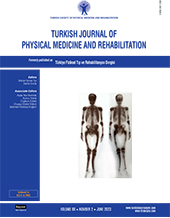Relationship of muscle thickness, strength, and diaphragm function in adults with cystic fibrosis
2 Department of Physical Medicine and Rehabilitation, Marmara University Medical Faculty, Istanbul, Türkiye
3 Department of Radiology, Marmara University Medical Faculty, Istanbul, Türkiye DOI : 10.5606/tftrd.2023.10361 Objectives: This study aimed to evaluate the muscle thickness, strength, and diaphragmatic function and relate them with clinical findings.
Patients and methods: The cross-sectional study was conducted with 54 participants (27 males, 27 females; mean age; 24.5±5.3 years; range, 18 to 45 years) between January 2017 and October 2017. Of the participants, 31 were adult CF patients, and 23 were age-and sex-matched controls. Patient demographics, 6-min walk distance, body mass index (BMI), and fat-free mass index (FFMI) were evaluated. Each patient underwent pulmonary function tests. Quadriceps femoris thickness and diaphragm thickening fraction were assessed by ultrasonography. Upper extremity strength was measured with a handheld dynamometer.
Results: There was no difference between the patients` and controls` BMI (p=0.052). However, patients` FFMI was lower than the controls` (p=0.010). The FFMI correlated with pulmonary function tests. Patients` both right and left quadriceps femoris muscles were thinner than the controls (p=0.001 and p=0.001, respectively). Patients with pancreatic insufficiency had thinner muscles than patients without pancreatic insufficiency. The control group had a stronger handgrip than CF patients (33.5±10.1 vs. 24.5±9.2 kg, p=0.003).
Conclusion: Peripheral muscle wasting and weakness and lower functional capacity are highly prevalent in CF patients.
Keywords : Cystic fibrosis, diaphragm, quadriceps femoris

















